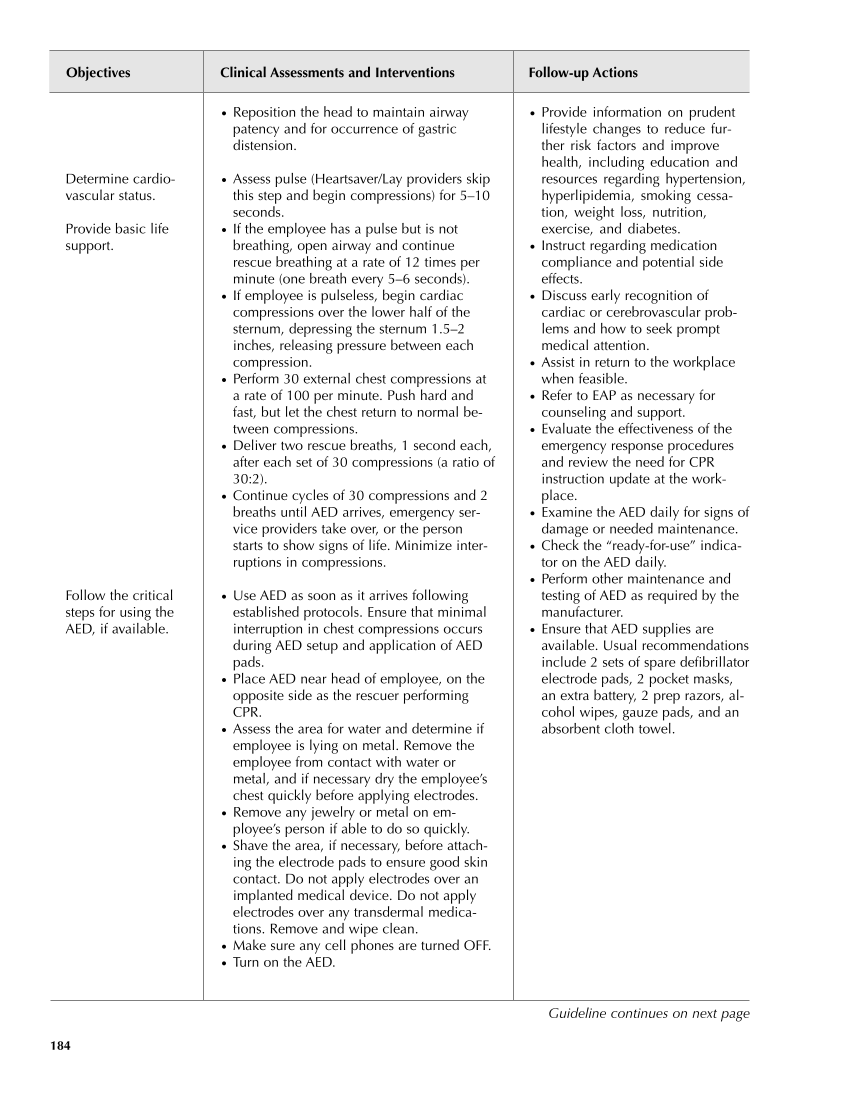Objectives Clinical Assessments and Interventions Follow-up Actions 184 ● Provide information on prudent lifestyle changes to reduce fur- ther risk factors and improve health, including education and resources regarding hypertension, hyperlipidemia, smoking cessa- tion, weight loss, nutrition, exercise, and diabetes. ● Instruct regarding medication compliance and potential side effects. ● Discuss early recognition of cardiac or cerebrovascular prob- lems and how to seek prompt medical attention. ● Assist in return to the workplace when feasible. ● Refer to EAP as necessary for counseling and support. ● Evaluate the effectiveness of the emergency response procedures and review the need for CPR instruction update at the work- place. ● Examine the AED daily for signs of damage or needed maintenance. ● Check the “ready-for-use” indica- tor on the AED daily. ● Perform other maintenance and testing of AED as required by the manufacturer. ● Ensure that AED supplies are available. Usual recommendations include 2 sets of spare defibrillator electrode pads, 2 pocket masks, an extra battery, 2 prep razors, al- cohol wipes, gauze pads, and an absorbent cloth towel. Determine cardio- vascular status. Provide basic life support. Follow the critical steps for using the AED, if available. ● Reposition the head to maintain airway patency and for occurrence of gastric distension. ● Assess pulse (Heartsaver/Lay providers skip this step and begin compressions) for 5–10 seconds. ● If the employee has a pulse but is not breathing, open airway and continue rescue breathing at a rate of 12 times per minute (one breath every 5–6 seconds). ● If employee is pulseless, begin cardiac compressions over the lower half of the sternum, depressing the sternum 1.5–2 inches, releasing pressure between each compression. ● Perform 30 external chest compressions at a rate of 100 per minute. Push hard and fast, but let the chest return to normal be- tween compressions. ● Deliver two rescue breaths, 1 second each, after each set of 30 compressions (a ratio of 30:2). ● Continue cycles of 30 compressions and 2 breaths until AED arrives, emergency ser- vice providers take over, or the person starts to show signs of life. Minimize inter- ruptions in compressions. ● Use AED as soon as it arrives following established protocols. Ensure that minimal interruption in chest compressions occurs during AED setup and application of AED pads. ● Place AED near head of employee, on the opposite side as the rescuer performing CPR. ● Assess the area for water and determine if employee is lying on metal. Remove the employee from contact with water or metal, and if necessary dry the employee’s chest quickly before applying electrodes. ● Remove any jewelry or metal on em- ployee’s person if able to do so quickly. ● Shave the area, if necessary, before attach- ing the electrode pads to ensure good skin contact. Do not apply electrodes over an implanted medical device. Do not apply electrodes over any transdermal medica- tions. Remove and wipe clean. ● Make sure any cell phones are turned OFF. ● Turn on the AED. Guideline continues on next page
Purchased from OEM Press by (ge corporate access). (C) 2013 OEM Health Information, Inc. All rights reserved.












































































































































































































































































































































































































































